The Burial of the Sardine
- Tags:
 Erasmus party Murcia,
Murcia,
Spain
Erasmus party Murcia,
Murcia,
Spain
- Website: www.entierrodelasardina.es
The Burial of the Sardine in Murcia!
The Burial of the Sardine is celebrated in Murcia during the Spring Festival. These always take place the week after Easter Week in Spain, and the day of the burial is celebrated on the Saturday of the following week, though it has in the past been celebrated on the preceding Thursday or Friday.
The Burial of the Sardine marks the end of the Spring Festival, and you're in luck, as the person who's going to tell you all about this celebration has taken part in the parade as a hachonera (I'll explain later exactly what this means).
The Burial of the Sardine also coincides with the end of the February carnevals, since other Spanish and Latin American cities celebrated on these days, though ours in Murcia is far more special - it's actually considered a Celebration of National Touristical Interest.
It's a Pagan festival which dates back to the nineteenth century, and the role of the sardine comes from the fact that no meat can be eaten during Lent until it's burned, symbolising the end of the ban. This is the more logical reason behind the celebration, though others believe that it forms part of a ritual to guarantee fish in the coming year.
So that you can easily understand what happens during the festival, I'll explain the main characters to you:
First, what you should know is that the sardineros belong to certain groups which take their names from Roman mythology. There are a total of twenty-four: Apollo, Selene, Athena, Momus, hercules, Jupiter, Ceres, Achilles, Ulysses, Pluto, Neptune, Morpheus, Mars, Diana, Dionysus, Vulcan, Polyphemus, Saturn, Odin, Mercury, Eros, Centaur and Centro Brujo. The festival is primarily for these groups, who spend the whole year preparing for it, although it's only appreciated for a few days. For the citizens, they are people dressed in attractive costumes who give out toys on the streets, but as someone who's seen what they do from the inside, I can tell you that it's much more than this. They live with a strong sentiment of commitments, socialise among themselves and organise meet-ups, prepare the toys they're going to give out, prepare the floats, take care of the hachoneros and make sure they're enjoying themsevles, etc.

Every group has its own float, and these parade through the streets on the Saturday afternoon. I think they're great, they're very unique as each one is different, and decorated according to the elements which characterize their mythological group.

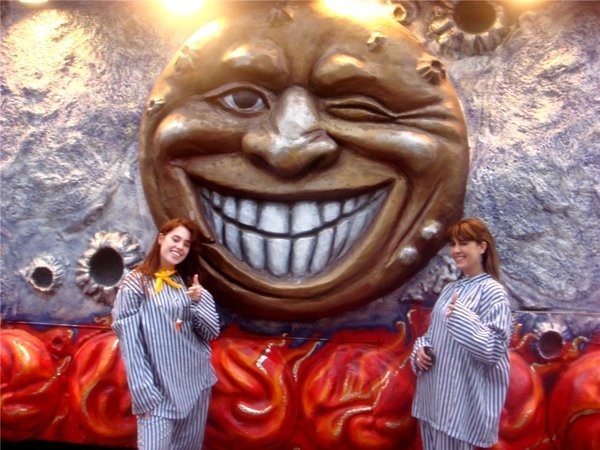

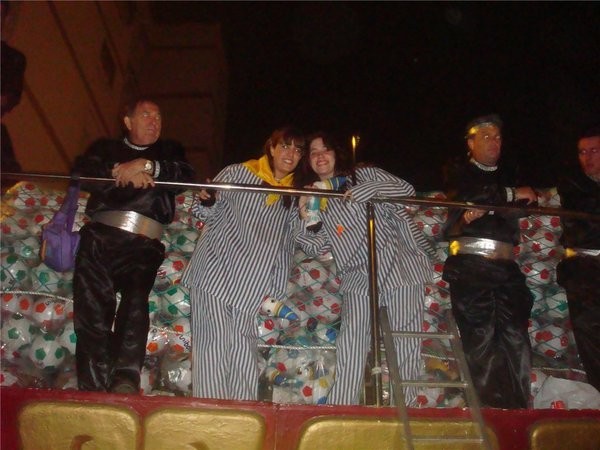
I started off with the Hercules group for one year, and the following four I've been in the Mars group, apart from in 2014 when I was away on my Erasmus exchange and was extremely disappointed not to be able to participate and come home to see my sardine merchant group, who I have a lot of respect for, since they are great with us and I've made good friends with them.
You'll be asking what exactly it is that I do during the festival - well, I'm a hachonera (written with a since I'm a girl! ) The hachoneros are the people you see during that week wearing what looks like striped pyjamas with a cone on their head, holding whistles and other accessories in the street. We accompany the sardine merchants and are in charge of holding the torches to light up the streets, and which symbolise the fire which will later be used to burn the sardine. We also make sure that the crowd doesn't come to close to the floats. They pay us symbolically for these few days, and we get free lunch and drinks every day. This is definitely one of my best 'jobs'.

On the other side is someone dressed as the sardine, which is usually the same boy for years at a time, who accompanies the parade through the streets. At the end of the parade, the material sardine is waiting at the end of Gran Vía.
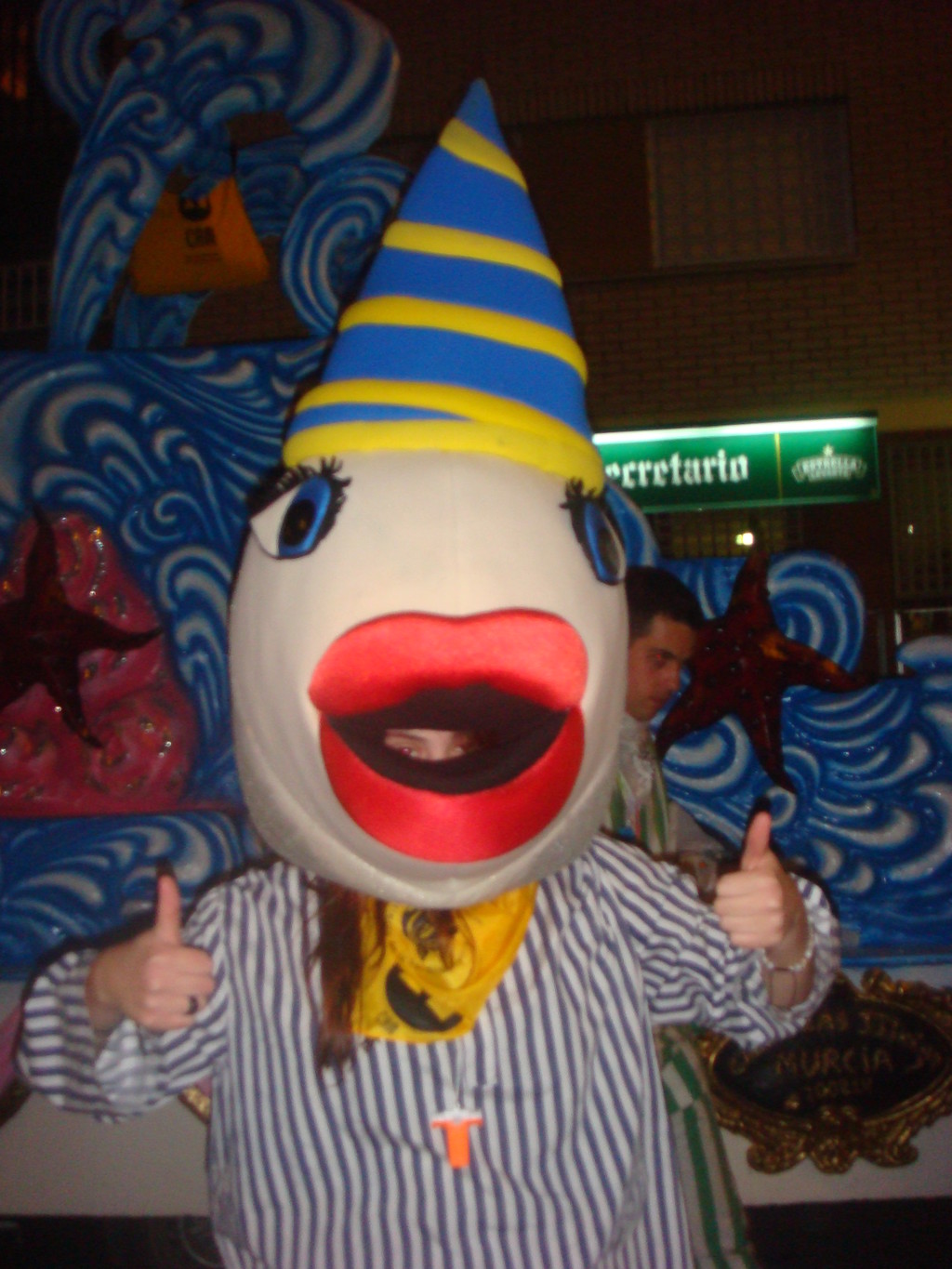
Finally, other important characters are Big Fish and Ms Sardine, who are usually celebrated persons in Murcian region and who change every year. They play an important role in the festival, and their function is more symbolic.
There are parades and charanga bands on the Thursday and Friday afternoons in Murcia city centre, with the hachoneros, sardineros and music groups all dancing to the rhythm in the streets. The Thursday parade is shorter than the Friday one, and the Friday one shorter than the Saturday parade.
The Thursday parade begins on Teniente General Gutiérrez Mellado, where the Centro Fama and Jesús Maria school are located, and continues down Jaime I until it reaches la Glorieta on Gran Vía. I think it starts at 8pm, but you can drink beer beforehand from the Estrella Levante stands, or watch the different sardine groups in the streets, where they sometimes perform a dance or give out toys, spreading joy wherever they go. Finally, the sardine is given to the President Sardinero by the mayor of Murcia on the main balcony in the Almudí Palace, and fireworks mark the end of the day.
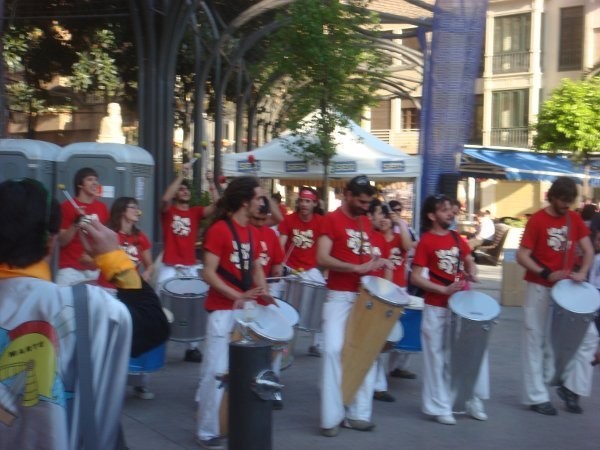
The Friday parade is longer. The sardineros change their costumes, since they have several and like to appear different and more vibrant each day. This parade begins on Plaza del Cardenal Belluga, and finished at la Glorieta passing through the Plaza de los Apóstoles, Correos Street, Santo Domingo and Gran Vía. There are also more charanga bands and other groups which participate in this parade. At la Glorieta, again on the main balcony of the city hall, Ms Sardinera's testament is read out at 10pm, which records the number of toys which will be given out during the parade on Saturday. It finishes again with fireworks.
You can also see the sardineros in the streets beforehand, but for less time, and if you go to Plaza del Cardenal Belluga, you'll see lots of people 'dressed up' and a huge, colourful party going on.
The Saturday morning parade is shorter still, since the one in the afternoon is the biggest of all. Again, the sardineros parade through Murcia city centre with their hachoneros and music groups, until they meet again at Plaza del Cardenal Belluga and give a short parade alone, passing down Trapería Street, continuing onto Santo Domingo and Alfonso X El Sabio. At the end, there's a small firework display on Plaza Circular.
In my opinion the Saturday parade is the most difficult to orchestrate, since the streets are very narrow and the crowds are excited to receive the toys. You can also tell that everyone is pretty tired. Afterwards, the sardineros go out for a meal at a restaurant, and the hachoneros to another one or home to eat, and at 6pm or so everyone proceeds to the Infante to prepare for the big parade.

You can only enter the Infante on this day if you're taking part in the parade or if you're a VIP, but since I've been there several times, I'll tell you what happens. The sardineros' floats are ordered on the street according to what order they will proceed in (this order changes every year), while the characters, such as the Brazilians who dance half-naked, dragons, baton twirlers, etc. socialise, prepare themselves, eat meat pastries, dance, etc.
I love this part before the actual parade starts. It's the most entertaining bit since you get to know loads of people and can see the start of the parade, dance, climb on the floats... When the floats have begun to depart, the hachoneros get ready to help prevent people from getting too close to the sardineros. I'm lucky since my group's float, Mars, is very high and only needs a hachonero in each corner to keep it secure, so the rest walk behind it torches in hand without problems. Most of the floats however have the hachoneros stationed all around them, since people are less likely to come too close to the fire to get the toys. There are a lot of crazy people though, who would risk their life and the lives of the hachoneros to get hold of some toys.
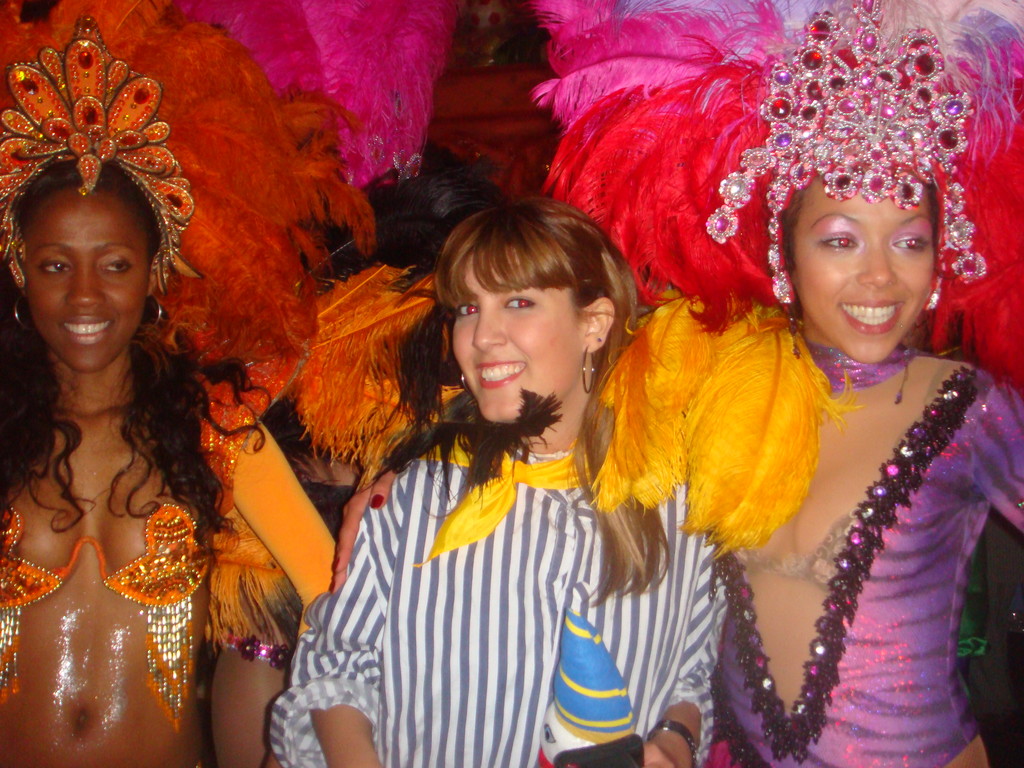

The Saturday evening parade leaves from the Infante, continuing on through Floridablanca, Puente de los Peligros, Gran Vía, Avenida de la Constitución and Plaza Circular before finishing at Primo de Rivera. It's a long way, but it always seems short to me as I'm busy looking at people, listening and dancing to the float's music, etc. The only problem is that if you start to need the loo, you can't go, and can end up feeling pretty uncomfortable - I speak from experience! At the end of the parade, buses take us back to Puente de los Peligros, where the burning of the sardine takes place. During the bus ride, we sing, dance and laugh... enjoying the short festival time we have remaining, and beginning to feel a little deflated as it's almost over.
At 1am or so the burning takes place, just at the end of Gran Vía. You see the sardine and almost feel sad, as just its structure is left over. Before the burning, a show is put on to entertain those present until the time arrives. Big Fish and Ms Sardina light the sardine, and it burns brightly. The heat from the fire is immense, but they put it out soon afterwards with water. There are also some amazing fireworks to mark the end of this three day festival.
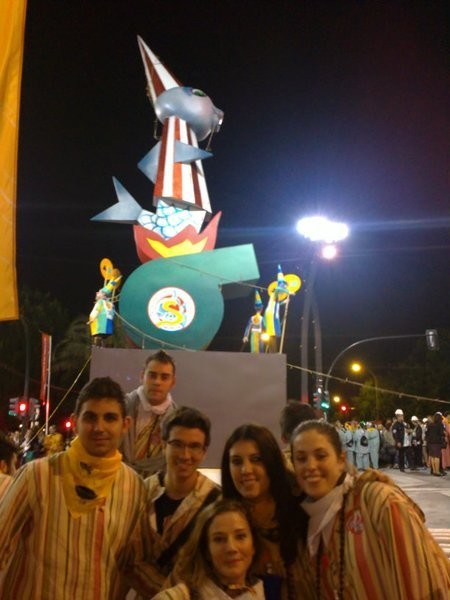
The only negative thing I have to say about the festival is that although there are also sardineras (female members of the groups), they're not allowed to stand on the floats on Saturday night. Apparently this is due to safety issues, tradition, etc., but it seems very outdated and sexist to me.
On the following day, everything goes back to normal and the stalls are taken down, and we have to wait another year to enjoy the Spring Festival once more.
Photo gallery
Content available in other languages
- Español: ¡El Entierro de la Sardina de Murcia!
- Français: L'enterrement de la Sardine de Murcia!
- Italiano: La Sepoltura della Sardina di Murcia!
Rate and comment about this place!
Do you know The Burial of the Sardine? Share your opinion about this place.






























